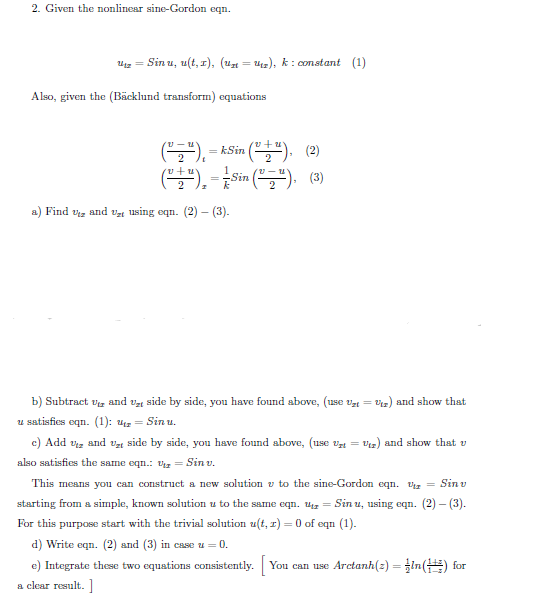2. Given the nonlinear sine-Gordon eqn. ua - Sin u, u(t, z), (4 = tig), k: constant (1) Also, given the (Bücklund transform) equations (),- Si -(), (2) -kSin Sin a) Find t, and ty tasing eqn. (2) – (3).
2. Given the nonlinear sine-Gordon eqn. ua - Sin u, u(t, z), (4 = tig), k: constant (1) Also, given the (Bücklund transform) equations (),- Si -(), (2) -kSin Sin a) Find t, and ty tasing eqn. (2) – (3).
Advanced Engineering Mathematics
10th Edition
ISBN:9780470458365
Author:Erwin Kreyszig
Publisher:Erwin Kreyszig
Chapter2: Second-order Linear Odes
Section: Chapter Questions
Problem 1RQ
Related questions
Question
this lesson is PDE partial differential eqution

Transcribed Image Text:2. Given the nonlinear sine-Gordon eqn.
Uz = Sin u, u(t, r), (u = u), k: constant (1)
Also, given the (Bäcklund transform) equations
(S).-
(). - kSin (""). (2)
Sin
a) Find vz and Vt 1using eqn. (2) – (3).
b) Subtract vg and ve side by side, you have found sbove, (use v = Vz) and show thst
u satisfies eqn. (1): uz = Sin u.
c) Add vz and v, side by side, you have found above, (use v =
Vz) and show that v
also satisfies the same eqn.: Vz = Sin v.
This means you can construct a new solution v to the sine-Gordon eqn. Vg = Sin v
starting from a simple, known solution u to the same eqn. ug = Sin u, using eqn. (2) - (3).
For this purpose start with the trivial solution u(t, r) = 0 of eqn (1).
d) Write eqn. (2) and (3) in case u = 0.
e) Integrate these two equations consistently. You can use Arctanh(z) = In() for
%3D
a clear result.
Expert Solution
This question has been solved!
Explore an expertly crafted, step-by-step solution for a thorough understanding of key concepts.
Step by step
Solved in 2 steps with 1 images

Knowledge Booster
Learn more about
Need a deep-dive on the concept behind this application? Look no further. Learn more about this topic, advanced-math and related others by exploring similar questions and additional content below.Recommended textbooks for you

Advanced Engineering Mathematics
Advanced Math
ISBN:
9780470458365
Author:
Erwin Kreyszig
Publisher:
Wiley, John & Sons, Incorporated

Numerical Methods for Engineers
Advanced Math
ISBN:
9780073397924
Author:
Steven C. Chapra Dr., Raymond P. Canale
Publisher:
McGraw-Hill Education

Introductory Mathematics for Engineering Applicat…
Advanced Math
ISBN:
9781118141809
Author:
Nathan Klingbeil
Publisher:
WILEY

Advanced Engineering Mathematics
Advanced Math
ISBN:
9780470458365
Author:
Erwin Kreyszig
Publisher:
Wiley, John & Sons, Incorporated

Numerical Methods for Engineers
Advanced Math
ISBN:
9780073397924
Author:
Steven C. Chapra Dr., Raymond P. Canale
Publisher:
McGraw-Hill Education

Introductory Mathematics for Engineering Applicat…
Advanced Math
ISBN:
9781118141809
Author:
Nathan Klingbeil
Publisher:
WILEY

Mathematics For Machine Technology
Advanced Math
ISBN:
9781337798310
Author:
Peterson, John.
Publisher:
Cengage Learning,

